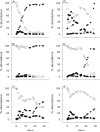An examination of the epiphytic nature of Gambierdiscus toxicus, a dinoflagellate involved in ciguatera fish poisoning
- PMID: 21966283
- PMCID: PMC3182139
- DOI: 10.1016/j.hal.2011.04.011
An examination of the epiphytic nature of Gambierdiscus toxicus, a dinoflagellate involved in ciguatera fish poisoning
Abstract
Twenty-four specimen of macroalgae were collected in nearshore waters of the island of Hawaii, identified, and maintained to examine how the epiphytic relationship between Gambierdiscus toxicus (isolate BIG12) varied among the macroalgal species. Gambierdiscus cells were introduced to petri dishes containing 100 g samples of each macroalgal host, which were examined at two, 16, 24, and every 24 to 72 hours thereafter, over a 29-day period. Gambierdiscus proliferated in the presence of some host species (e.g., Galaxaura marginata and Jania sp.), but grew little in the presence of other species (e.g., Portieria hornemannii). Gambierdiscus exhibited high survival rates (>99%) in the presence of Chaetomorpha sp., but died before the end of the experiment (after 21 days) with other host species (e.g., Dictyota and Microdictyon spp.). Gambierdiscus avoided contact with Portieria hornemannii, but averaged up to 30% attachment with other host species. The numbers of Gambierdiscus cells belonging to one of three classes (alive and attached; alive and unattached; and dead) were determined for each time point. The 24 algal hosts were grouped according to their commonalities relative to these three classes using a Bray-Curtis similarity index, similarity profile (SIMPROF) permutation tests, and multi-dimensional scaling (MDS) analysis (PRIMER 6). The resultant six groupings were used to construct different Gambierdiscus growth profiles for the different algal hosts. Group A is characterized by a preponderance of unattached cells and high mortality rates. Groups B, C, E, and F also displayed high proportions of unattached cells, but mortality either occurred later (Groups B and C) or rates were lower (Groups E and F). Group D had the highest proportion of attached cells. Group E contained three out of the four chlorophyte species, while Group F contained the majority of the rhodophytes. Over 50% of the species in Group F are considered to be palatable, whereas Groups A, B, and C are composed of species that exhibit chemical defenses against herbivory. The results of this study coupled with previous findings indicate that Gambierdiscus is not an obligate epiphyte; it can be free-swimming and found in the plankton. The conditions that lead to changes between epiphytic and planktonic stages need to be better studied in order to determine how they affect Gambierdiscus growth and physiology, connectivity and dispersion mechanisms, and toxin movement up into the foodweb.
Figures




References
-
- Abbott IA. Marine Red Algae of the Hawaiian Islands. Bishop Museum Press; Honolulu, HI: 1999.
-
- Abbott IA. Hawaiian herbivorous fish; what algae are they eating, or what's left?. In: Hokama Y, Scheuer PJ, Yasumoto T, editors. International Symposium on Ciguatera and Marine Natural Products; Honolulu, HI: Asian Pacific Research Foundation; 1995. pp. 11–18.
-
- Abbott IA, Huisman JM. Marine Green and Brown Algae of the Hawaiian Islands. Bishop Museum Press; Honolulu, HI: 2004.
-
- Adachi R, Fukuyo Y. The thecal structure of a marine toxic dinoflagellate Gambierdiscus toxicus gen. et sp. nov. collected in a ciguatera-endemic area. Bull. Jpn. Soc. Sci. Fish. 1979;45:67–71.
-
- Arthur KE, McMahon KM, Limpus CJ, Dennison WC. Feeding ecology of green turtles (Chelonia mydas) from Shoalwater Bay, Australia. Marine Turtle Newsletter. 2009;123:6–12.
Grants and funding
LinkOut - more resources
Full Text Sources
Research Materials
Miscellaneous

